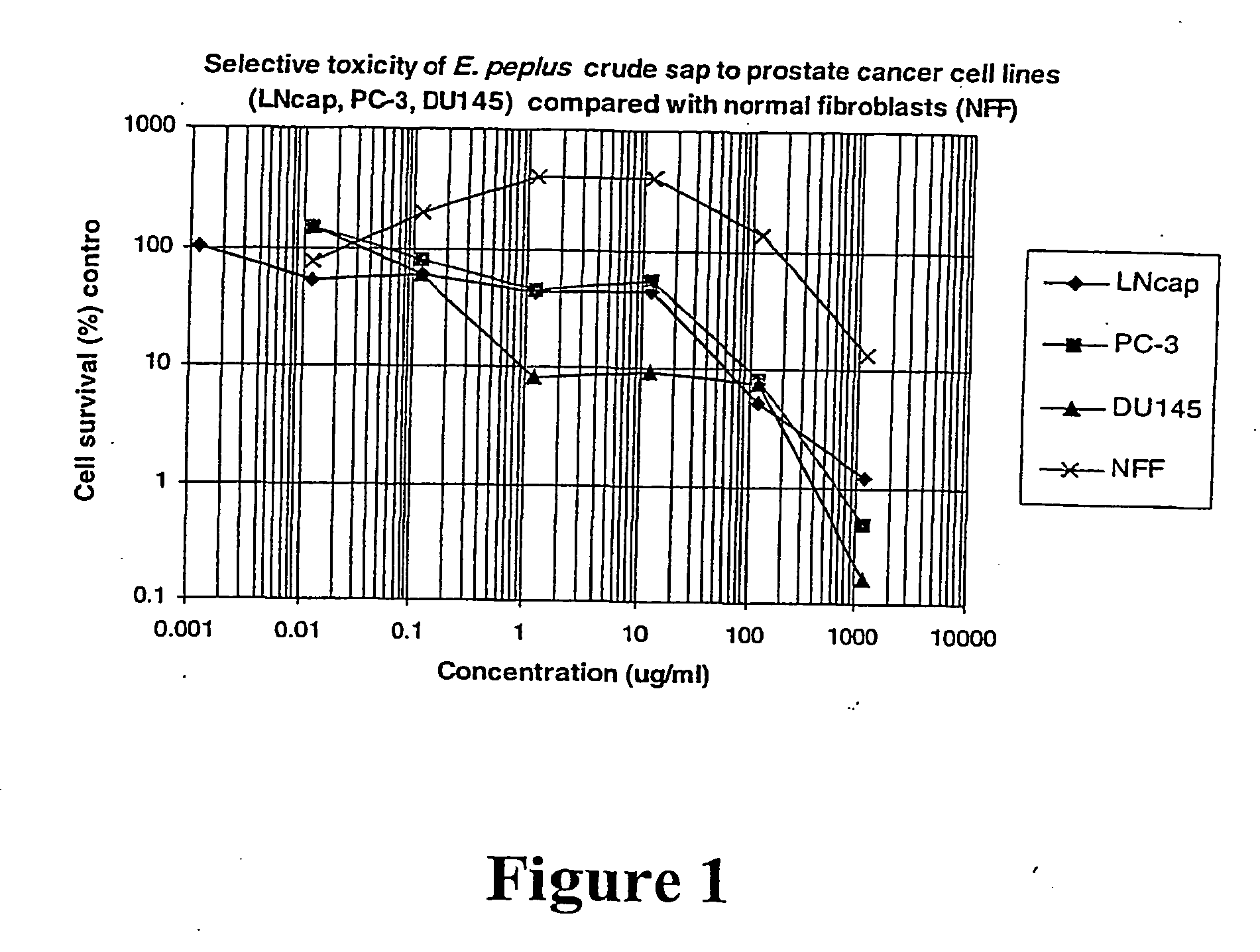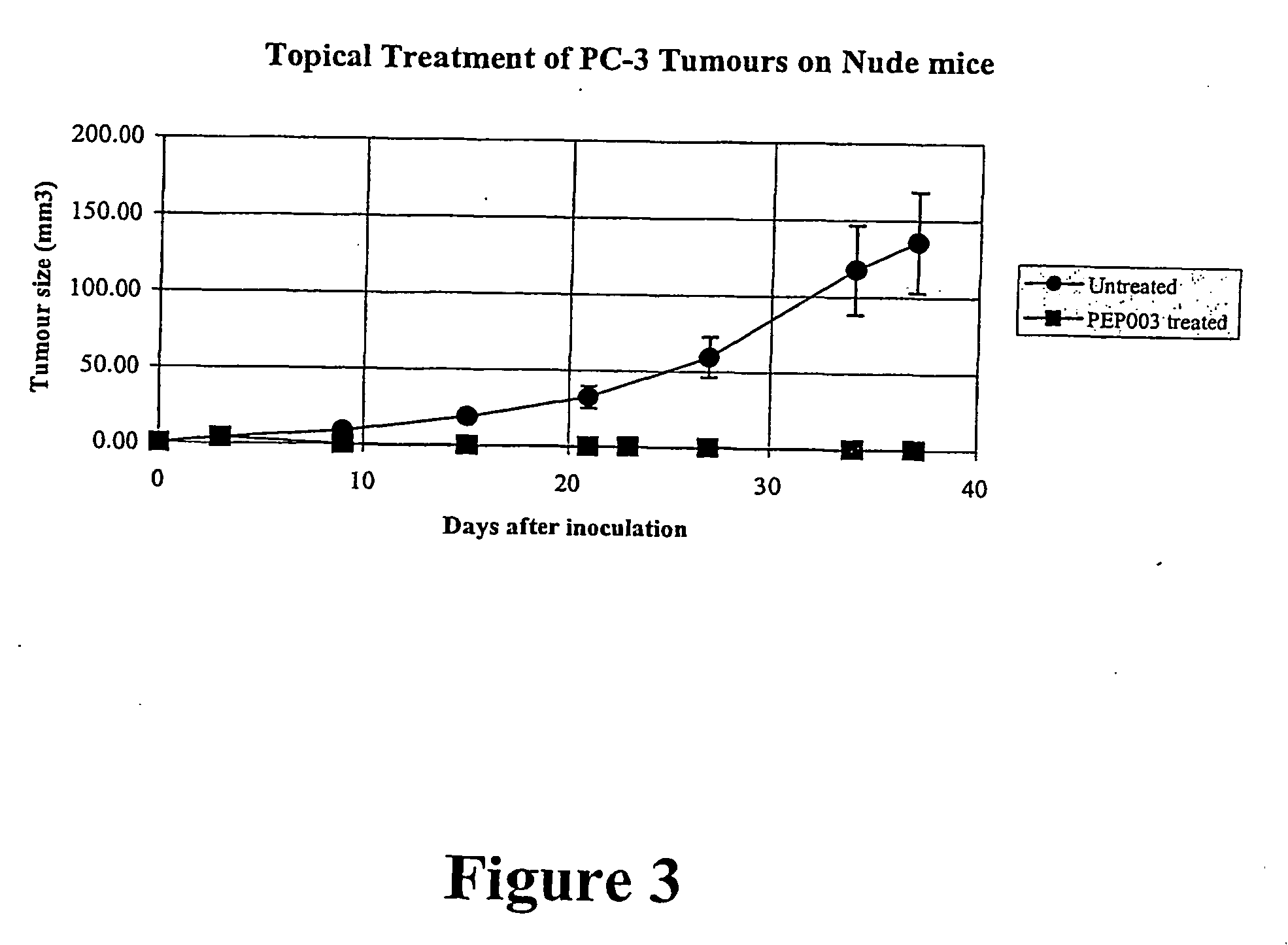Treatment of prostate cancer
a prostate cancer and treatment technology, applied in the field of chemical agents, can solve the problems of prostate cancer, serious health problems, significant morbidity and death directly from the prostate cancer, etc., and achieve the effects of treating or prophylaxis, treatment or prophylaxis of a subject, and prostate cancer treatment and/or prophylaxis
- Summary
- Abstract
- Description
- Claims
- Application Information
AI Technical Summary
Benefits of technology
Problems solved by technology
Method used
Image
Examples
example 1
Materials and Methods
[0150] Cells were cultured in RPMI1640 medium-10% w / v FCS in 5% v / v CO2 and 5% v / v oxygen. The latter reproduces physiological conditions and is considered useful in assessing the molecular responses of normal and tumor cells to drugs. Inhibition of cell growth was determined 5-7 days after drug treatment by assay of cell numbers with sulforhodamine B (SRB) in microtitre plates.
[0151] General cell signalling activity of the E. peplus compounds is quantitated by a sensitive assay which the present inventors have developed, in which cells are simultaneously treated with the drug and infected with a non-relicating adenovirus containing the CMV promoter, which drives expression of β-galactosidase (in place of E1a). Approximately 24 hours later, the β-galactosidase activity is measured in an ELISA reader. The sensitivity of this assay (<1 ng / ml TPA) is sufficient to measure bioactivity in blood and organs and serves as the basis for comparison of structures and for...
example 2
Pre-Treatment of Human Tumor Cells in Culture with Diterpene Esters Potentiates Selective Killing by Untreated Leukocytes
[0155] The question of whether drug treatment of the target tumor cells causes them to become susceptible to effector cells of the immune system was addressed as follows.
[0156] Leukocytes obtained by lysis of human peripheral blood were added to 5000 MM96L human melanoma cells or 7000 neonatal foreskin fibroblasts per microtitre well at effector: target ratios of 1000, 100 and 10:1. The target cells had been treated with 60 ng / mL PEP008 for 20 hr beforehand, and washed and the medium replaced before the leukocytes were added. After 48 hr incubation with the leukocytes the cultures were washed and labelled with [3H]-thymidine for 2 hr. At 100:1 ratio of effector:target cells, the melanoma cells showed 12% survival with PEP00S whereas the normal fibroblasts had 100% survival. Untreated leukocytes had no effect on cell survival.
[0157] This result showed that the d...
example 3
Effect of E. peplus Sap on Prostate Cancer Cells
[0158] The ability of E. peplus sap to kill prostate cancer cells selectively was assessed by comparing the effect of the sap on prostate cancer cell lines and on normal fibroblasts.
[0159] Three prostate cancer cell lines were used; PC-3 and DU145 are hormone resistant prostate cancer cell lines and LNcap is a hormone-sensitive prostate cancer cell line.
[0160] The prostate cancer cell lines or normal fibroblasts were suspended to a concentration of 5×103 cells / well in RPMI1640 tissue culture medium containing 10% w / v FCS, volume 0.1 ml in microtitre plates.
[0161] The cells were incubated for 6 hr at 37° C., followed by the addition of E. peplus crude sap (approximately 110 mg dry solids per ml) to the final dilutions, as shown in FIG. 1. After days, cells were scored visually for survival morphology changes and survival was also assessed by 3H-thymidine incorporation into cell mass. The results are expressed as percentages of cell ...
PUM
| Property | Measurement | Unit |
|---|---|---|
| volume | aaaaa | aaaaa |
| concentrations | aaaaa | aaaaa |
| concentration | aaaaa | aaaaa |
Abstract
Description
Claims
Application Information
 Login to View More
Login to View More - R&D
- Intellectual Property
- Life Sciences
- Materials
- Tech Scout
- Unparalleled Data Quality
- Higher Quality Content
- 60% Fewer Hallucinations
Browse by: Latest US Patents, China's latest patents, Technical Efficacy Thesaurus, Application Domain, Technology Topic, Popular Technical Reports.
© 2025 PatSnap. All rights reserved.Legal|Privacy policy|Modern Slavery Act Transparency Statement|Sitemap|About US| Contact US: help@patsnap.com



